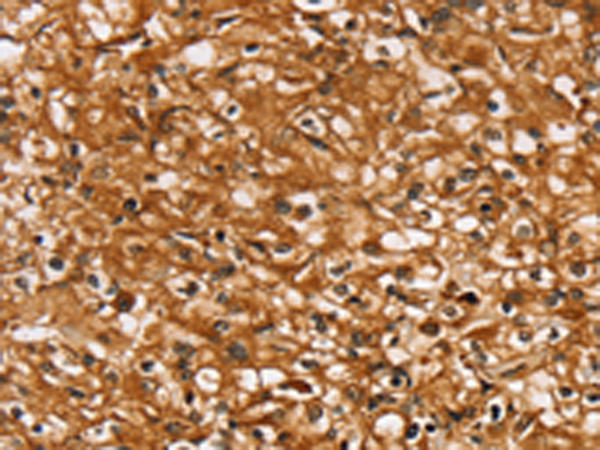
| WB | 咨询技术 | Human,Mouse,Rat |
| IF | 咨询技术 | Human,Mouse,Rat |
| IHC | 1/25-1/100 | Human,Mouse,Rat |
| ICC | 技术咨询 | Human,Mouse,Rat |
| FCM | 咨询技术 | Human,Mouse,Rat |
| Elisa | 1/1000-1/2000 | Human,Mouse,Rat |
| Host/Isotype | Rabbit IgG |
| Antibody Type | Primary antibody |
| Storage | Store at 4°C short term. Aliquot and store at -20°C long term. Avoid freeze/thaw cycles. |
| Species Reactivity | Human |
| Immunogen | Synthetic peptide of human SLC26A6 |
| Formulation | Purified antibody in PBS with 0.05% sodium azide and 50% glycerol. |
+ +
以下是3-4条关于SLC26A6抗体的参考文献摘要示例(仅供参考,具体文献需根据实际检索验证):
1. **"SLC26A6 mediates Cl⁻/HCO3⁻ exchange in the mouse duodenum"**
- **作者**: Wang Z. et al.
- **摘要**: 本研究使用特异性SLC26A6抗体通过免疫组化和Western blot验证了该蛋白在小鼠十二指肠上皮细胞的表达,发现其介导Cl⁻/HCO3⁻交换功能,影响肠道酸碱平衡。
2. **"Role of SLC26A6 in pancreatic ductal HCO3⁻ secretion"**
- **作者**: Ishiguro H. et al.
- **摘要**: 通过SLC26A6抗体进行免疫荧光定位,揭示了该蛋白在胰腺导管细胞的顶膜表达,并证实其与CFTR协同调控HCO3⁻分泌,对胰液碱性化至关重要。
3. **"SLC26A6 deficiency predisposes to hyperoxaluria and kidney stones"**
- **作者**: Jiang Z. et al.
- **摘要**: 利用SLC26A6敲除小鼠模型及抗体检测,发现该蛋白在肾脏中参与草酸盐转运,其缺失导致尿草酸盐排泄增加,增加肾结石风险。
4. **"Interaction of SLC26A6 with CFTR: Functional and immunohistochemical analysis"**
- **作者**: Ko S.B. et al.
- **摘要**: 通过共聚焦显微镜结合SLC26A6抗体,证明其与CFTR在上皮细胞中的共定位,并揭示两者在Cl⁻/HCO3⁻交换中的协同作用机制。
(注:以上内容为示例,实际文献需通过PubMed/Google Scholar检索确认。)
The SLC26A6 antibody is a crucial tool for studying the solute carrier family 26 member 6 (SLC26A6), a transmembrane anion exchanger encoded by the *SLC26A6* gene. SLC26A6. also known as PAT1 or CFEX, facilitates the transport of chloride, bicarbonate, oxalate, sulfate, and other anions across epithelial cell membranes. It is prominently expressed in the apical membranes of the kidney, pancreas, and small intestine, where it plays a vital role in pH homeostasis, electrolyte balance, and oxalate secretion. Dysregulation of SLC26A6 is implicated in pathologies like kidney stones, pancreatic insufficiency, and metabolic disorders.
The SLC26A6 antibody, typically generated in rabbits or mice, targets specific epitopes of the protein, enabling its detection in techniques such as Western blotting, immunohistochemistry, and immunofluorescence. Polyclonal antibodies are commonly used due to their high affinity for multiple antigenic sites. Validation often includes knockout controls or siRNA-based silencing to confirm specificity. Research applications focus on elucidating SLC26A6’s physiological roles in ion transport mechanisms, its interaction with other transporters (e.g., CFTR), and its contribution to disease pathways. Studies in rodent models and human tissues highlight its therapeutic potential in managing hyperoxaluria, diabetes, and digestive disorders. The antibody’s utility extends to drug development screens targeting anion exchange processes. Overall, it serves as a cornerstone for exploring SLC26A6’s multifaceted functions in health and disease.
×